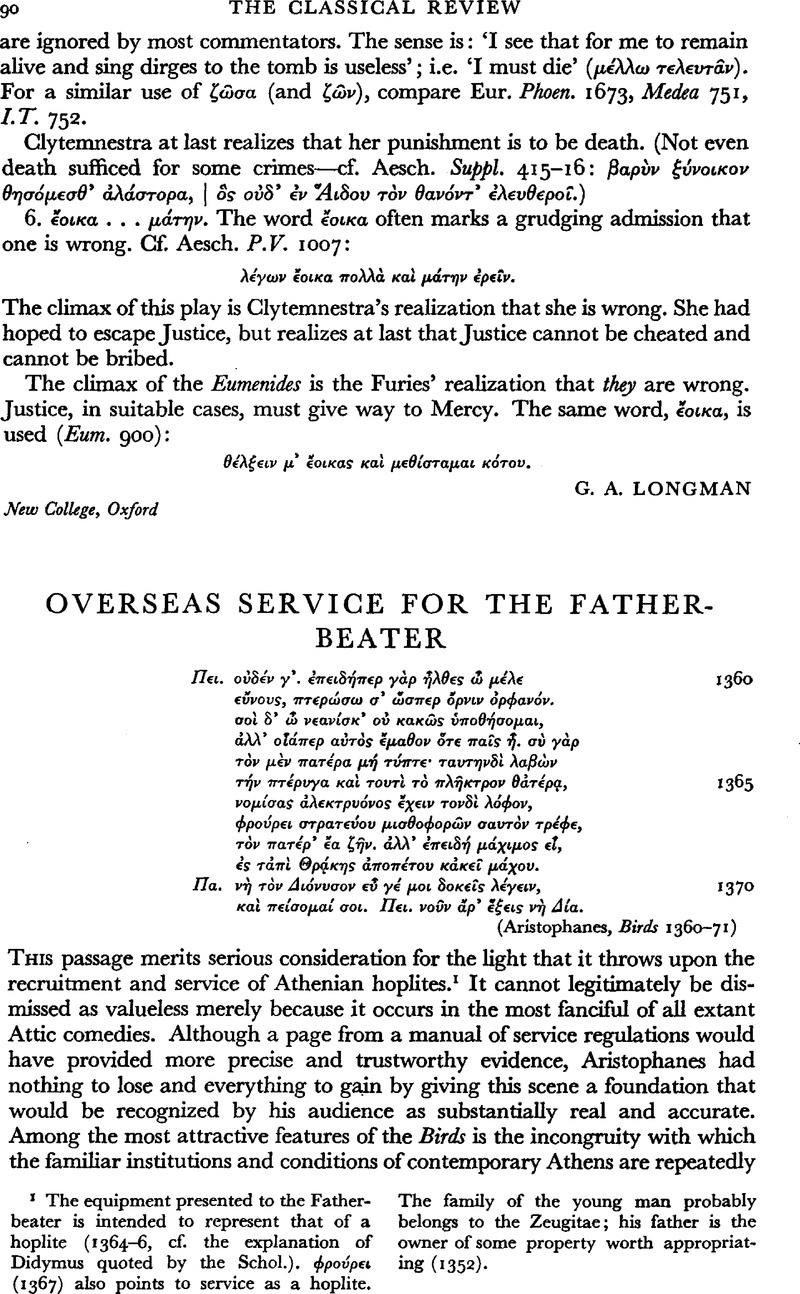Article contents
Overseas Service for the Father-Beater
Published online by Cambridge University Press: 13 February 2009
Abstract

Information
- Type
- Review Article
- Information
- Copyright
- Copyright © The Classical Association 1954
References
page 90 note 1 The equipment presented to the Father-beater is intended to represent that of a hoplite (1364–6, cf. the explanation of Didymus quoted by the Schol.). φρούρει (1367) also points to service as a hoplite. The family of the young man probably belongs to the Zeugitae; his father is the owner of some property worth appropriating (1352).
page 91 note 1 Examples on the military side are 448–50 and 1177–8, on the legal side 1660–6 (where the law attributed to Solon may be compared with Isaeus vi. 47 and [Dem.] xliii. 51).
page 91 note 2 Murray, , Aristophanes, pp. 151–152.Google Scholar
page 91 note 3 It is by no means certain that twenty was the age-limit in the fifth century, as it was later. Gomme, C.Q,. xxi (1927), 142, draws attention to the absence of evidence on the age of the νεώτατοι (Thuc. i. 105. 4 and ii. 13. 6–7), who did not normally serve outside Attica.
page 91 note 4 Cf. Kromayer in Kromayer–Veith, , Heerwesen u. Kriegführung d. Gr. u. Röm., p. 48Google Scholar. Thuc. vi. 24. 3 (cf. Diod. xiii. 2. 2) refers mainly to the Thetes, who were not conscripted for hoplite service.
page 91 note 5 The Young Man in the Plutus is described indiscriminately as v. (1016, 1071, 1201) and μ. (975, 1038, 1096); cf. Antiphon iii δ 5–6, Lys. iii. 10.
page 91 note 6 Cf. Murray, , Aeschylus, p. 155.Google Scholar
page 91 note 7 In Hdt. iii. 53. 7 it is applied to Lycophron, the son of Periander, at the time of his death; he was seventeen when his mother was killed (ibid. 50. 1), but the story shows that he outlived her by a number of years. The term is used by Aristophanes (Thesm. 134) of Agathon when at least thirty (though it is here chosen for a special reason). In some passages, as Aristoph. Knights 731 and Thuc. viii. 69. 4, 92. 6, νεανίσκοι are young men of good family of whom some, if not all, are probably at least twenty. Fourth-century writers, especially Plato, use the word very loosely. In Hellenistic times νεανίσκοι seem normally to have been older than ἔφηβοι (Forbes, , NEOI, p. 61Google Scholar). Cf. Diod. xiii. 14. 4.
page 92 note 1 Aesch. iii. 154; cf. Thuc. ii. 46. 1, Lys. fr. 42 b (Thalheim), Plato, Menex. 248 e–249 b, Isocr. viii. 82. They are described by Aeschines and Lysias as νεανίσκοι.
page 92 note 2 Translators have tried to reproduce the play upon this word; so ‘puisque tu es batailleur’ (Van Daele).
page 92 note 3 It may be added that the use of νεοτγός by Peithetairus when referring to the customs and laws of the birds (1350, 1357) perhaps strengthens the case for believing the Father-beater to be very young.
page 92 note 4 Cf. Antiphon fr. 69 (Thalheim), which is cited in this connexion by Bryant, , Harv. Stud, xviii (1907), p. 82, n. 4.Google Scholar
page 92 note 5 Marrou, , Histoire de l'éducation dans l'anti-quité, p. 481Google Scholar, provides an admirable summary of current opinions.
page 92 note 6 Ἀθ. πολ. 42. 2–5.
page 92 note 7 Murray in his recent translation of the Birds renders φρούρει στραγεύου (1367) ‘first year in a fortress, then active service’. He apparently believes that the ephebic system described by Aristotle existed in 414 and seeks to reconcile this passage with it. As stated above, there seems to be no reason to date its introduction so early. Murray assumes that φρούρει refers to garrison service in Attica. The word is, however, often used by Thucydides of static defence in other areas, including Chalcidice (cf. i. 64. 1, v. 39. 1). There were Athenian φρούρια outside Attica.
page 93 note 1 If the forces operating in Sicily were successful in implementing the plans for western expansion, the northern Aegean coast might well lose its importance.
page 93 note 2 The enlistment of non-Athenians as περίπολοι, which was introduced before 411 (Thuc. viii. 92.2; Lys.xiii. 71), was probably an emergency measure designed to release young citizens for service abroad.
page 93 note 3 Thuc. vii. 9.
page 93 note 4 The Schol. is mistaken in believing that the Father-beater is to serve as a mercenary 4598.2 (cf. van Leeuwen, n. ad loc), but his error perhaps contains an element of truth, Ordinary hoplites received special pay at Potidaea (Thuc. iii. 17. 4).
page 93 note 5 Mathieu, , Mélanges Desrousseaux, pp. 315–317Google Scholar, makes the attractive suggestion that the military side of the Ephebeia was evolved from the practice of maintaining and training war-orphans. Here perhaps is a preliminary stage of this development.
page 93 note 6 Murray, , Aristophanes, pp. 151–152Google Scholar; berg, Ehrenthe, People of Aristophanes 2, p. 59.Google Scholar
- 2
- Cited by

